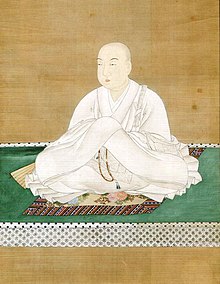Emperor Seiwa
Emperor Seiwa (清和天皇, Seiwa-tennō, 847–31 December 878) was the 56th emperor of Japan,[1] according to the traditional order of succession.[2] Seiwa's reign started in 858 and ended in 876.[3]
| Seiwa | |
|---|---|
| Emperor of Japan | |
 | |
| Reign | 858–876 |
| Predecessor | Montoku |
| Successor | Yōzei |
| Born | 847 Kyoto (Heian-kyō) |
| Died | 31 December 878 (aged 31) Kyoto |
| Burial | Minooyama no misasagi (Kyoto) |
Traditional history
changeThis prince's personal name (imina) was Korehito (惟仁) before he became the monarch.[4] In the Imperial House of Japan, Korehito was the first to have the suffix "-hito" 仁 in his name.
Korehito was the fourth son of Emperor Montoku. His mother was the daughter of Fujiwara no Yoshifusa (藤原良房), who was regent and great minister of the council of state.[5]
Events of Seiwa's life
changePrince Korehito became emperor at the age of 8, but the real power was held by his grandfather, Yoshifusa.
- 10 July 858 (Ten'an 2, 27th day of the 8th month): In the 8th year of Montoku-tennō 's reign (文徳天皇8年), the emperor abdicated.[4] The succession (senso) was received by a his son. Then Emperor Seiwa is said to have acceded to the throne (sokui).[6] This was confirmed in ceremonies.[7]
- 15 December 858 (Ten'an 2, 7th day of the 11th month): When Prince Korehito became emperor at age 9, his grandfather became regent (sesshō). This was the first time that this role was given to a member of the Fujiwara family. Also, it was the first time that someone so young became emperor.[4]
- 859 (Jōgan 1): Construction begins on the Iwashimizu Shrine in honor of Hachiman, the Shinto war god.[8]
- 859 (Jōgan 1, 1st month): Mourning for the death of Emperor Montoku was nationwide.[9]
- 869 (Jōgan 10): Yōzei was born, and he is named Seiwa's heir in the following year.[10]
- 876 (Jōgan 17, 11th month): In the 18th year of Seiwa's reign, he abdicated.[10]
- 878 (Gangyō 2): Seiwa becomes a Buddhist priest.[8]
- 31 December 878 (Gangyō 2, 4th day of the 12th month ): Former-Emperor Seiwa died at age 31.[11] He became known as emperor as Mizunoo-no-mikado[5] or Minoo-tei.[12]
After his death
changeThe actual site of Seiwa's grave is known. This emperor is traditionally venerated at a memorial Shinto shrine (misasagi) at Kyoto. The Imperial Household Agency designates this location as Seiwa's mausoleum.[1] It is formally named Minooyama no misasagi.[13] From the site of his tomb, he was sometimes referred to as Mizunoo (水尾).
The kami of Emperor Seiwa is venerated at Seiwa-tennō-sha in Saga, Yamashiro province.[14]
Eras of reign
changeThe years of Seiwa's reign are identified by more than one era name or nengō.[4]
Related pages
changeReferences
change- ↑ 1.0 1.1 Imperial Household Agency (Kunaichō), 清和天皇 (56); retrieved 2011-10-27.
- ↑ Ponsonby-Fane, Richard. (1959). The Imperial House of Japan, p. 66.
- ↑ Klaproth, Julius von (1834). Nipon o dai itsi ran: ou Annales des empereurs du Japon. Oriental Translation Fund. pp. 115–121.
- ↑ 4.0 4.1 4.2 4.3 Klaproth, Julius von (1834). Nipon o dai itsi ran: ou Annales des empereurs du Japon. Oriental Translation Fund. p. 115.
- ↑ 5.0 5.1 5.2 Varley, p. 166.
- ↑ Jien; Delmer Myers Brown, Ichirō Ishida (1979). 愚管抄: A Translation and Study of the Gukansho, an Interpretative History of Japan Written in 1219. University of California Press. p. 286. ISBN 978-0-520-03460-0.
- ↑ Varley, p. 44; a distinct act of senso is unrecognized prior to Emperor Tenji; and all sovereigns except Jitō, Yōzei, Go-Toba, and Fushimi have senso and sokui in the same year until the reign of Emperor Go-Murakami. Compare Imperial Household Agency (Kunaichō), Ceremony of Accession (Sokui-no-Rei); retrieved 2011-12-23.
- ↑ 8.0 8.1 Jien; Delmer Myers Brown, Ichirō Ishida (1979). 愚管抄: A Translation and Study of the Gukansho, an Interpretative History of Japan Written in 1219. University of California Press. p. 288. ISBN 978-0-520-03460-0.
- ↑ Klaproth, Julius von (1834). Nipon o dai itsi ran: ou Annales des empereurs du Japon. Oriental Translation Fund. p. 116.
- ↑ 10.0 10.1 Klaproth, Julius von (1834). Nipon o dai itsi ran: ou Annales des empereurs du Japon. Oriental Translation Fund. p. 122.
- ↑ Jien; Delmer Myers Brown, Ichirō Ishida (1979). 愚管抄: A Translation and Study of the Gukansho, an Interpretative History of Japan Written in 1219. University of California Press. p. 289. ISBN 978-0-520-03460-0.
- ↑ Ponsonby-Fane, p. 8.
- ↑ Ponsonby-Fane, p. 421.
- ↑ Ponsonby-Fane, p. 128.
Other websites
changeMedia related to Emperor Seiwa at Wikimedia Commons
| Preceded by Emperor Montoku |
Emperor of Japan: Seiwa 858–876 |
Succeeded by Emperor Yōzei |